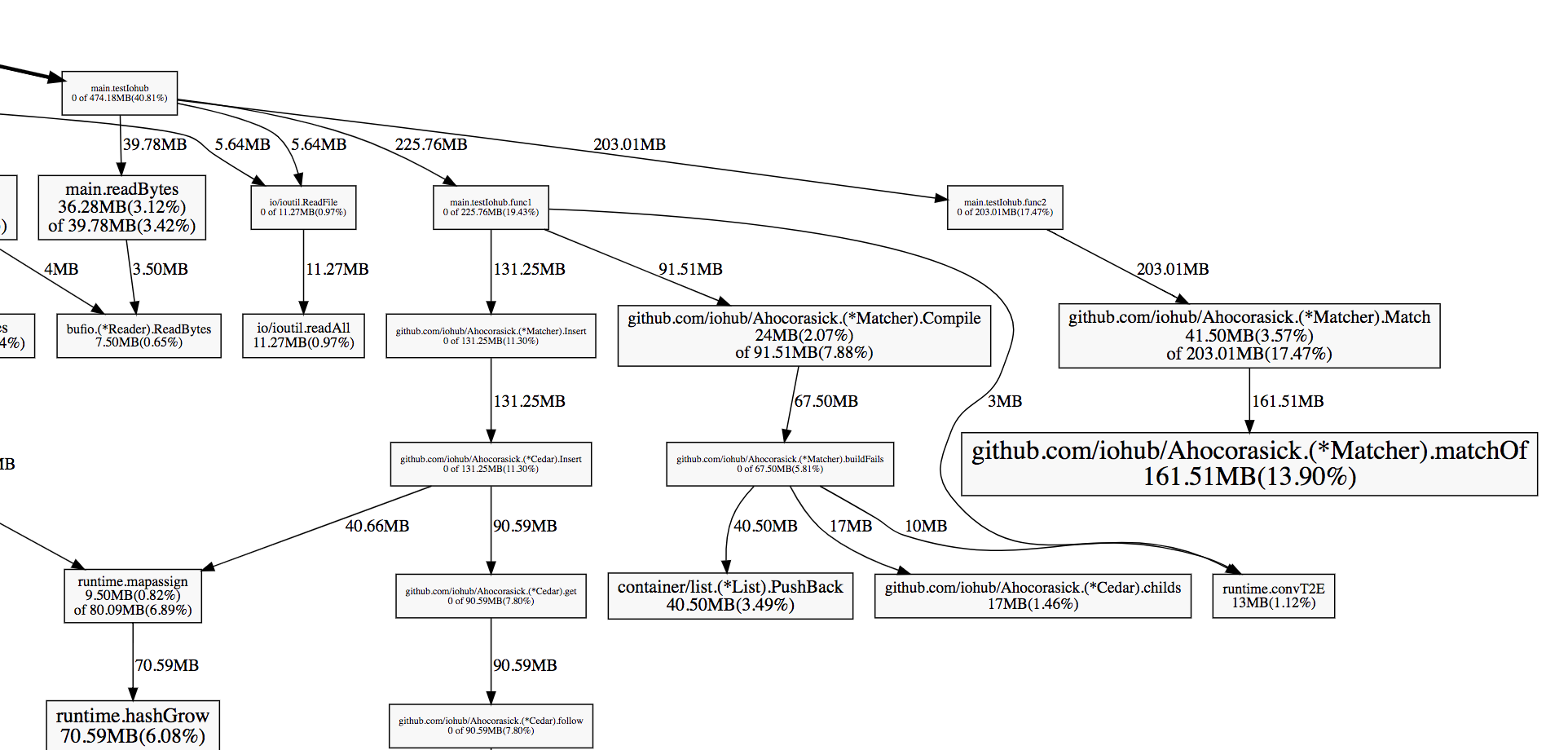使用pprof分析变量逃逸过程
-
问题背景
在优化ac自动机时发现在匹配过程中有大量时间消耗在GC里面,通过pprof发现match过程有很多的临时变量逃逸到heap里,增加了很多的GC压力,简要记录下问题定位的过程。
-
问题定位
首先需要在测试程序添加生成pprof数据的代码段。
f, err := os.Create("benchmark.prof") if err != nil { log.Fatal(err) } defer f.Close() pprof.StartCPUProfile(f) defer pprof.StopCPUProfile() go func() { http.ListenAndServe(":8787", http.DefaultServeMux) }() ... // 等待一段时间做问题分析 fmt.Println("\nCTL+C exit http pprof") time.Sleep(15 * time.Minute)查看各函数调用申请的内存对象大小。
go tool pprof -alloc_space -svg http://localhost:8787/debug/pprof/heap > ~/Desktop/go_heap.svg
我们发现matchOf申请了大量的内存,于是怀疑matchOf可能存在变量逃逸,使用-gcflags -m重新生成测试程序发现确实存在MatchToken临时变量逃逸到heap。
go build -gcflags -m | grep escape ../acmatcher.go:165: &MatchToken literal escapes to heap ../acmatcher.go:165: &MatchToken literal escapes to heap
问题修复
使用interface{}实现的泛型fixedbuf存在变量逃逸情况,直接使用slice做固定的buf.
// FixedBuffer fixed reuse buffer for zero alloc type FixedBuffer struct { b interface{} idx int cap int op iBufferOP } type iBufferOP interface { assign(fb *FixedBuffer, val interface{}) init(fb *FixedBuffer, n int) } func (fb *FixedBuffer) push(t interface{}) { if fb.idx >= fb.cap { panic("ERROR buffer overflow") } fb.op.assign(fb, t) fb.idx++ } func (fb *FixedBuffer) reset() { fb.idx = 0 } func NewFixedBuffer(n int, op iBufferOP) *FixedBuffer { fb := &FixedBuffer{ // b: make([]interface{}, n), idx: 0, cap: n, op: op, } fb.op.init(fb, n) return fb }优化后,函数调用完全ZeroAlloc,达到了使用fixedbuffer的预期.
type mbuf struct { token []MatchToken at []matchAt ti, ai int } func (mb *mbuf) reset() { mb.ai, mb.ti = 0, 0 } func (mb *mbuf) addToken(mt MatchToken) { if mb.ti >= TokenBufferSize { panic("ERROR buffer overflow") } mb.token[mb.ti] = mt mb.ti++ } func (mb *mbuf) addAt(mt matchAt) { if mb.ai >= MatchBufferSize { panic("ERROR buffer overflow") } mb.at[mb.ai] = mt mb.ai++ } -
问题原因
首先我们来看下面这个变量逃逸示例
func main() { lc := 1 s := make([]interface{}, lc) s[0] = lc } func main2() { lc := 1 s := make([]*int, lc) s[0] = &lc } go run -gcflags='-m -m' sample2.go ./sample2.go:5: make([]interface {}, lc) escapes to heap ./sample2.go:6: lc escapes to heapmake从堆申请,这点无可厚非,我们把interface{}改为int类型后
func main() { lc := 1 s := make([]int, lc) s[0] = lc } go run -gcflags='-m -m' sample2.go ./sample2.go:5: make([]interface {}, lc) escapes to heapmake得到的slice是在堆申请的,生命周期比函数更长,当slice里为引用时变量会转移到堆,而interface{}能接收任意类型,在做逃逸分析时,保守的认为输入的值可能是引用,所以把变量移到堆里去了。stackoverflow相关资料:
makefor a slice returns a slice descriptorstruct(pointer to underlying array, length, and capacity) and allocates an underlying slice element array. The underlying array is generally allocated on the heap:make([]*int, lc) escapes to heap from make([]*int, lc).s[0] = &vstores a reference to the variablev(&v) in the underlying array on the heap:&v escapes to heap from s[0] (slice-element-equals),moved to heap: v. The reference remains on the heap, after the function ends and its stack is reclaimed, until the underlying array is garbage collected.If the
makeslice capacity is a small (compile time) constant,make([]*int, 1)in your example, the underlying array may be allocated on the stack. However, escape analysis does not take this into account.